Key takeaways:
- Attendance is just a starting point; engagement levels, such as average watch time and interactions, are crucial for understanding webinar success.
- Analyzing performance metrics, like drop-off rates and feedback surveys, can significantly improve future webinars and audience connection.
- Key Performance Indicators (KPIs) include engagement metrics and conversion rates, which directly reflect attendees’ interest and subsequent actions taken.
- Post-webinar feedback, both quantitative and qualitative, provides essential insights for refining content and presentation style for future sessions.
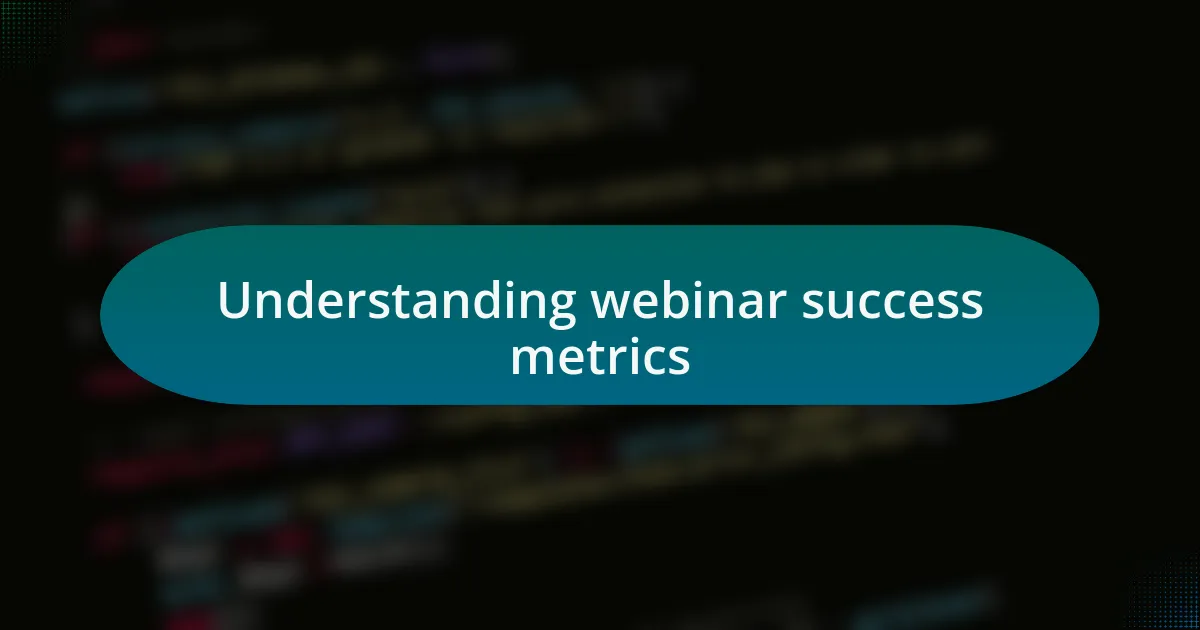
Understanding webinar success metrics
When I look at webinar success metrics, I often find that attendance is just the tip of the iceberg. Sure, seeing a high number of participants can feel rewarding, but what truly matters to me is the engagement level during the event. Did they ask questions? Were they visibly attentive, or did they drop off midway?
One time, I hosted a webinar that had a solid turnout, but I noticed that engagement waned after the first fifteen minutes. It really hit me that simply filling virtual seats isn’t enough. To analyze real success, I now focus on metrics like the average watch time and participant interactions, which give deeper insights into the audience’s interests and pain points.
Feedback surveys are also a crucial part of my analysis. I cant help but feel a sense of fulfillment when I receive glowing reviews, but I also welcome constructive criticism. How many participants found the content valuable? Were there topics they wished we’d covered? These insights guide me in perfecting future webinars, ensuring that I’m not just speaking to an audience but truly connecting with them.
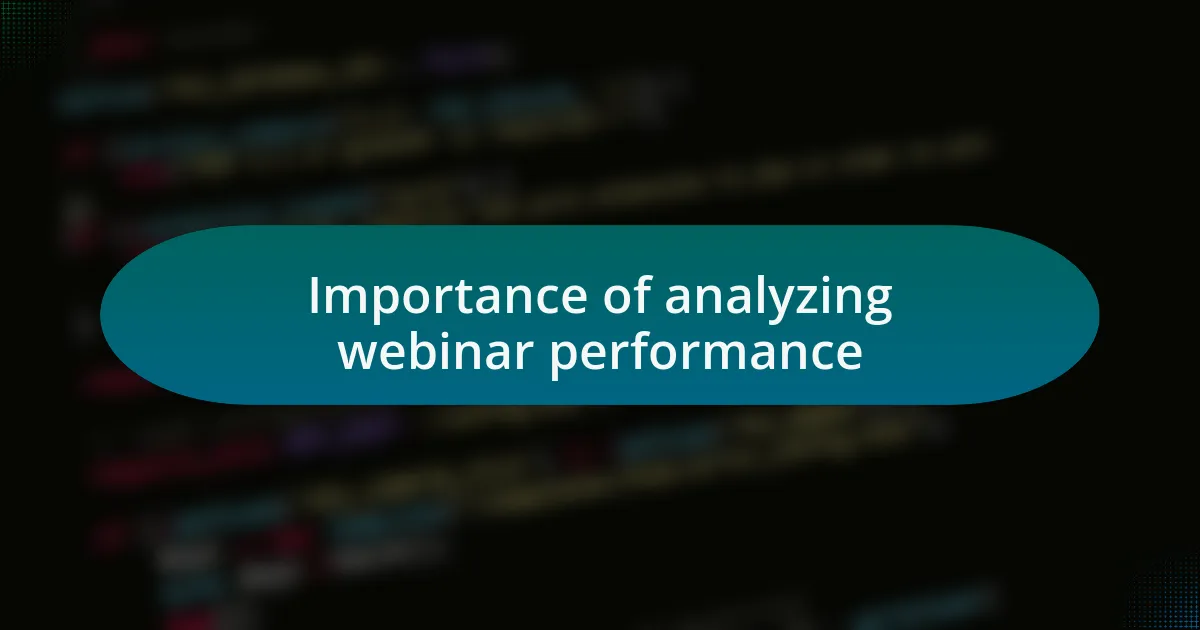
Importance of analyzing webinar performance
When I dive into analyzing webinar performance, the focus shifts from mere statistics to a more nuanced understanding of participant behavior. It’s striking how a single metric, like drop-off rates, can reveal so much about content resonance. I remember a session where engagement plummeted just when I shifted to a more complex topic. Reflecting on that, I realized how vital it is to adjust our presentation style based on participant feedback and interaction levels.
Engaging in this analysis isn’t just numbers—it’s about fostering a genuine connection with the audience. I often find myself pondering questions that arise during these evaluations, like, “What can I change to create a more engaging experience?” This reflection not only helps in refining my approach but also reminds me that each webinar is an opportunity for growth. A few months ago, I started incorporating interactive polls and Q&A segments, which dramatically increased participant engagement and satisfaction.
Taking the time to analyze webinar performance has transformed my approach to future events. By understanding what truly resonates with my audience, I feel a sense of direction and purpose in curating content. This practice has become essential, as it’s not just about informing; it’s about creating a compelling experience that prompts attendees to return—not just for the next webinar but to stay engaged with the broader conversation.
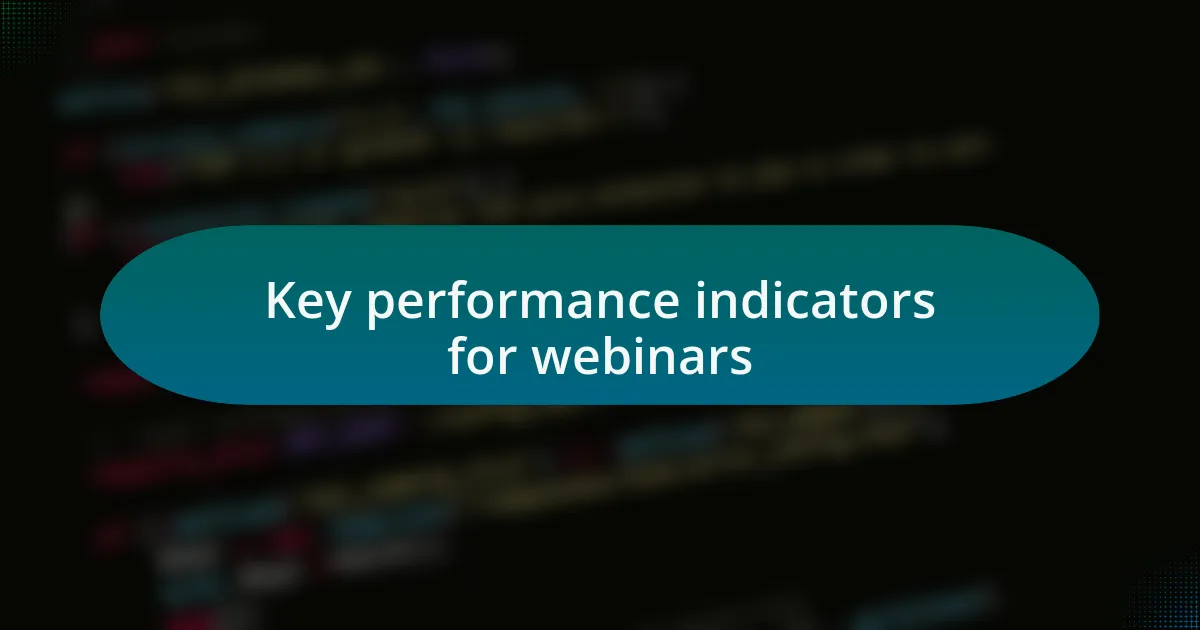
Key performance indicators for webinars
When it comes to key performance indicators (KPIs) for webinars, engagement metrics like attendance rates and interaction levels are essential. I recall hosting a webinar where I was thrilled to see a 75% attendance rate, but the thrill faded when I reviewed the chat log. The number of questions asked was surprisingly low, which led me to realize that audience engagement goes beyond just showing up.
Another critical KPI is the conversion rate, which reflects how many attendees take a desired action after the webinar, be it downloading resources or signing up for another event. I once conducted a follow-up survey that revealed insights into attendees’ motivations. It turned out that participants who felt their questions were answered during the session were significantly more likely to engage with additional content. This realization made me more intentional about encouraging open dialogue and addressing queries in real-time.
Lastly, the follow-up feedback is a goldmine of information. For instance, after another session, I collected feedback that highlighted how attendees would appreciate more real-life examples. That resonated with me deeply; it wasn’t just about the content delivered but how it connected to their professional challenges. This understanding of my audience’s preferences has motivated me to tailor future webinars accordingly, ensuring that each session is more aligned with their needs. Isn’t it fascinating how these KPIs can shape the journey of your webinars?
![]()
Tools for tracking webinar success
When it comes to tracking webinar success, tools like Google Analytics can be invaluable. I remember integrating it with my webinar platform and discovering that I could assess participant behavior on my registration page. It was enlightening to see where drop-offs occurred; this perspective made me reconsider the importance of a smooth signup process. Have you ever thought about how minor tweaks in your landing page could lead to significant gains in registrations?
Another powerful tool is webinar software like Zoom or GoToWebinar, which offers built-in analytics to measure engagement. I once delved into these analytics post-event and was surprised by the varying engagement rates throughout the session. Watching the graphs of attendee participation reminded me that pacing is vital; some segments held participants’ attention, while others didn’t resonate as well. It’s a humbling experience that underscores the need for continuous improvement.
Lastly, leveraging customer relationship management (CRM) systems, such as HubSpot, allows me to track attendee follow-ups in real-time. After a successful webinar, I was able to segment my audience and personalize my outreach based on their expressed interests. I found it incredibly rewarding to send tailored resources to attendees who showed a genuine interest in specific topics. Isn’t it amazing how targeted follow-ups can deepen connections and enhance content relevance?
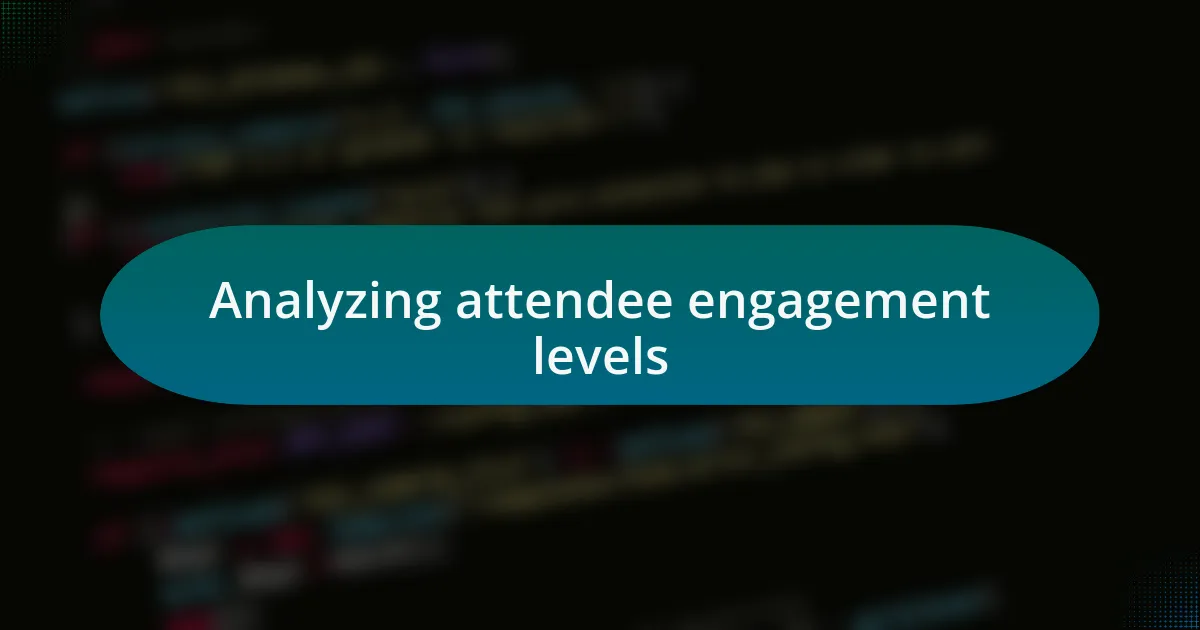
Analyzing attendee engagement levels
When analyzing attendee engagement levels during webinars, I often focus on the statistics provided by the embedded analytics of the platform. For instance, there was a time when I noticed a significant drop in attendance midway through a session. It made me question whether the content became monotonous or if I lost touch with the audience’s interests. Have you ever had that feeling of unease when you notice people’s attention fades? It’s like reading a room, but digitally.
Another aspect I consider is the chat interaction and Q&A participation. There was a memorable webinar where active discussion flourished in the chat, showing that attendees were not just passively listening; they were engaged and curious. I took that as a cue to adjust my approach in future sessions, realizing that fostering a two-way conversation amplifies interest. Isn’t it fascinating how a simple chat can reflect the pulse of your audience?
Lastly, I keep a close watch on post-webinar surveys. After one event, I implemented a follow-up survey asking for specific feedback about my presentation style and content. The responses provided me with rich insights that I had never anticipated. Engaging with attendees through surveys didn’t just yield data; it created an opportunity for dialogue that made my audience feel valued. Have you found feedback from your audience to be a game-changer in shaping your future content?
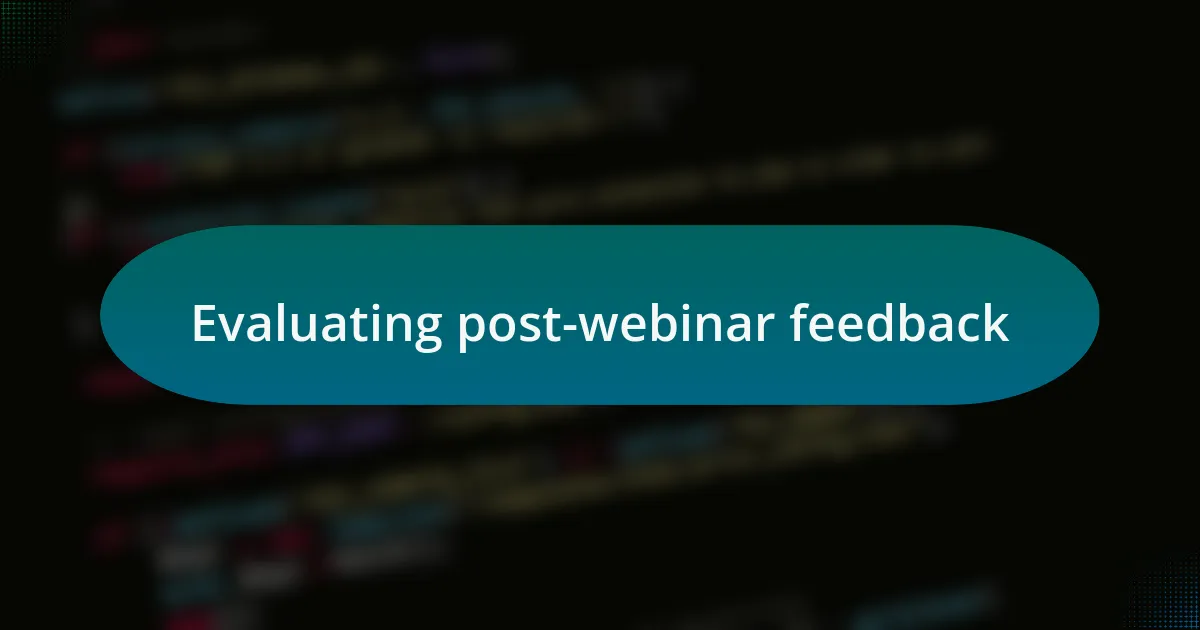
Evaluating post-webinar feedback
Gathering post-webinar feedback can feel like unearthing hidden gems of insight. After hosting a particularly intensive series of sessions, I decided to send out a brief survey with open-ended questions about what worked and what didn’t. The responses were sometimes surprising; attendees expressed a longing for more actionable takeaways. It made me realize that while I was sharing valuable information, I hadn’t been as clear about how to apply it. Have you ever received feedback that turned your perspective upside down?
The emotional resonance of the feedback is often just as important as the raw data. During one webinar, I received a heartfelt message from an attendee who shared how the content had profoundly impacted her career direction. It was a reminder that behind each statistic lies a real person with unique experiences and aspirations. Can you think of a time when a piece of feedback motivated you to refine your approach?
Additionally, I take note of the overall satisfaction scores, but I also look deeper into the accompanying comments. I once encountered a pattern where participants expressed confusion about a specific topic. This prompted me to explore new ways of presenting the material during follow-up sessions. Finding patterns in feedback not only enhances my webinars but helps me address potential stumbling blocks before they arise. How do you ensure that you’re truly hearing what your audience is trying to communicate?
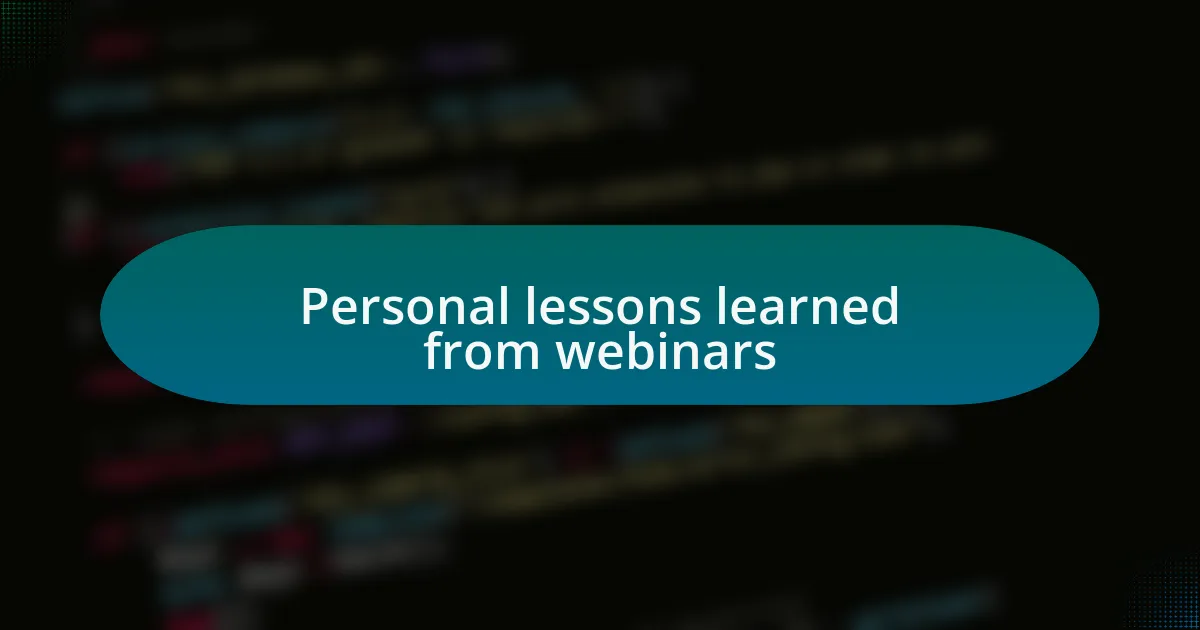
Personal lessons learned from webinars
I’ve learned that personal engagement during webinars can significantly enhance the experience for both me and the attendees. In one session, I encouraged participants to share their own experiences in real-time. The energy in the chat skyrocketed as stories flowed, which made the discussion feel more like a community dialogue rather than a one-sided presentation. Have you ever noticed how sharing your own experiences invites others to open up?
Another important lesson is the value of pacing. Early on, I was eager to pack in as much information as possible. However, I found that slowing down and allowing for pauses created space for reflection and questions, which led to deeper conversations. I remember one webinar where a simple ten-second pause after a complex idea prompted several impactful questions, reshaping the entire session’s dynamic. Have you considered how pacing can shape the interaction in your own presentations?
Lastly, I’ve developed a habit of revisiting the recorded sessions. Watching them from a listener’s perspective reveals so much about my delivery and engagement style. I once spotted moments where my enthusiasm waned, which impacted the audience’s energy. This realization inspired me to incorporate more dynamic elements, like storytelling, in future webinars. Have you ever reflected on your presentation style to uncover ways to connect more effectively with your audience?